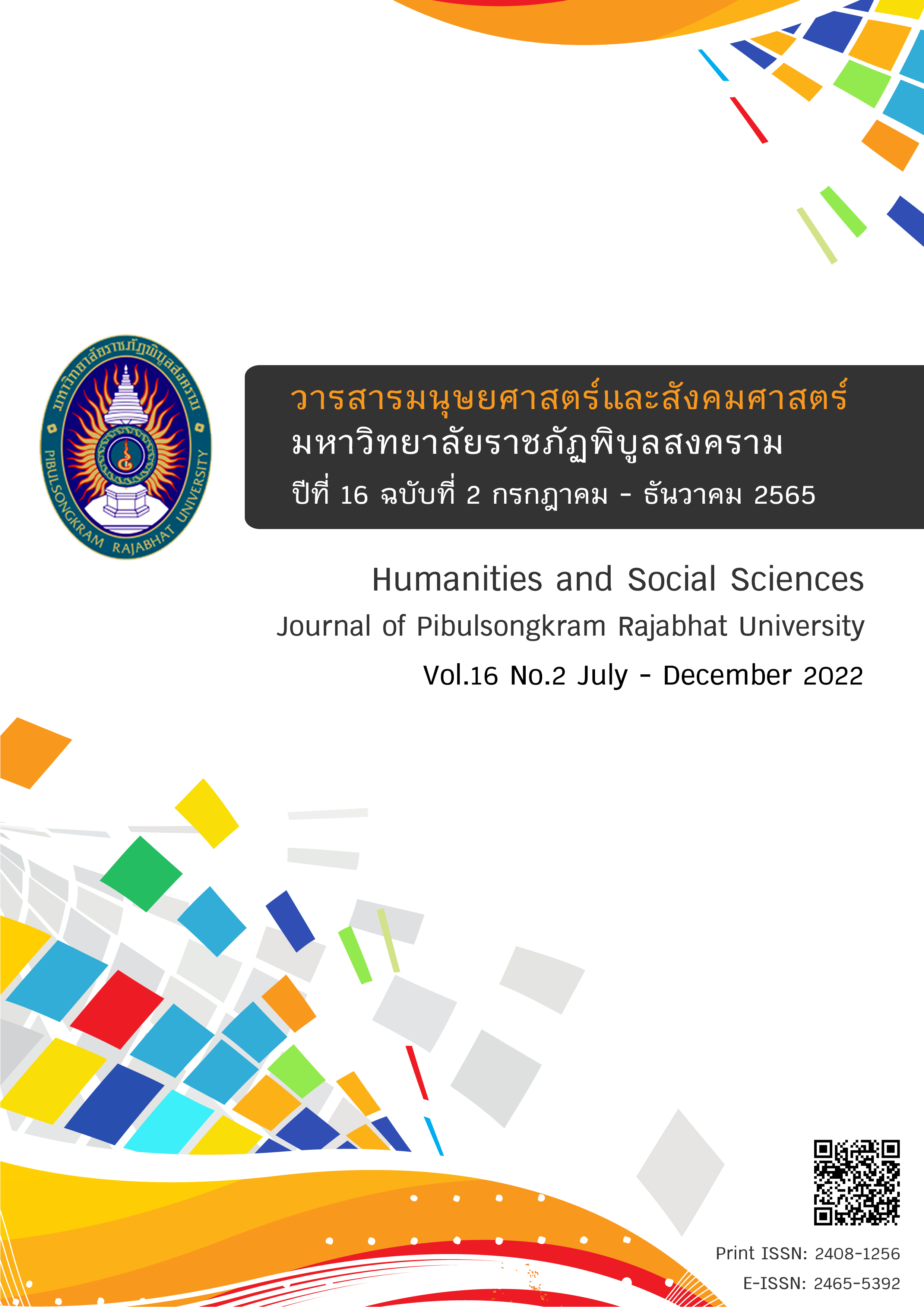Development of Grade 10 Students’ Scientific Explanation by Using Context-based Learning in Gastronomy
DOI:
https://doi.org/10.14456/psruhss.2022.50Keywords:
Scientific Explanation, Context-based Learning, GastronomyAbstract
This classroom action research aims to develop grade 10 student’s scientific explanation by using context-based learning in Gastronomy. Data were obtained from the Scientific Explanation Diagnostic Test. Data were then analyzed by grouping it into 3 ability levels: good, fair and improvement levels. Finding reveals that after learning through the context-based learning approach, the majority of students is in the good level (more than 50%). Many students are at the fair level (less than 36%). A few number of students is at the improvement level (10.71%). Findings from this study provide guidelines for teaching scientific explanation, particularly in the domain of context selection.
References
กาญจนา มหาลี, และ ชาตรี ฝ่ายคำตา. (2553). ความเข้าใจธรรมชาติวิทยาศาสตร์ของนักเรียนชั้นมัธยมศึกษาปีที่ 1. วารสารสงขลานครินทร์ ฉบับสังคมศาสตร์และมนุษย์ศาสตร์, 16(5), 795-809.
ณัฏฐพัชร์ ดุลยปภัสสร. (2562). การพัฒนาการสร้างคำอธิบายเชิงวิทยาศาสตร์ของนักเรียนระดับชั้นมัธยมศึกษาปีที่ 5 ในหน่วยการเรียนรู้เรื่อง การสลายอาหารระดับเซลล์ ด้วยการจัดการเรียนรู้แบบสืบเสาะหาความรู้ที่ใช้แบบจำลองเป็นฐาน (วิทยานิพนธ์ศึกษาศาสตรมหาบัณฑิต). มหาวิทยาลัยเกษตรศาสตร์, กรุงเทพฯ.
ตีรณา ชุมแสง. (2560). การพัฒนาความสามารถในการสร้างคำอธิบายเชิงวิทยาศาสตร์ เรื่อง สมดุลกล ของนักเรียนชั้นมัธยมศึกษาปีที่ 4 ด้วยการจัดการเรียนรู้โดยใช้บริบทเป็นฐาน (วิทยานิพนธ์ศึกษาศาสตรมหาบัณฑิต). มหาวิทยาลัยเกษตรศาสตร์, กรุงเทพฯ.
ลือชา ลดาชาติ, และ ลฎาภา สุทธกูล. (2555). การสำรวจและพัฒนาความเข้าใจธรรมชาติของวิทยาศาสตร์ของนักเรียนชั้นมัธยมศึกษาปีที่ 4. วารสารมหาวิทยาลัยนราธิวาสราชนครินทร์, 4(2), 73-90.
ลือชา ลดาชาติ, กมลรัตน์ ฉิมพาลี, ณิชัชฌา อาโยวงษ์, นพคุณ แงวกุดเรือ, สำเร็จ สระขาว, ชื่นหทัย หวังเอียด, และ จุฬารัตน์ ธรรมประทีป. (2558). การลงข้อสรุปและสร้างคำอธิบายทางวิทยาศาสตร์ของนักเรียนชั้นมัธยมศึกษาปีที่ 3. วารสารมหาวิทยาลัยศิลปากร ฉบับภาษาไทย, 35(1), 171-206.
ลือชา ลดาชาติ. (2558). การวิจัยเชิงคุณภาพสำหรับครูวิทยาศาสตร์. กรุงเทพฯ: จุฬาลงกรณ์มหาวิทยาลัย.
สถาบันส่งเสริมการสอนวิทยาศาสตร์และเทคโนโลยี. (2558). สรุปผลการวิจัยโครงการ. สืบค้น 2 เมษายน 2563, จาก www.timssthailand.ipst.ac.th
อรณิชา หงษ์เกิด. (2561). การพัฒนาการสร้างคำอธิบายเชิงวิทยาศาสตร์ของนักเรียนระดับชั้นมัธยมศึกษาปีที่ 5 ในหน่วยการเรียนรู้ เรื่อง ระบบต่อมไร้ท่อ โดยการจัดการเรียนรู้โดยใช้ประเด็นทางสังคมที่เกี่ยวเนื่องกับวิทยาศาสตร์เป็นฐาน (วิทยานิพนธ์ศึกษาศาสตรมหาบัณฑิต). มหาวิทยาลัยเกษตรศาสตร์, กรุงเทพฯ.
De Jong, O. (2006). Context-based chemical education: How to improve it. Chemical Education International, 8(1), 1-7.
Gilbert, J. K. (2006). On the Nature of Context in Chemical Education. International Journal of Science Education, 28(9), 957–976.
Inoue, N. (2015). Beyound Actions: Phycology of Action Research for Mindful Educational Improvement. New York: Peter Lang.
Kemis, S., & McTaggart, R. (1998). The Action Research Planner. Geelong: Deakin University Press.
McNeil, K. L., & Krajcik, J. (2006). Supporting Students' Construction of Scientific Explanation through Generic versus Context-Specific Written Scaffolds. The Journal of the Learning Sciences, 15(2), 153-191.
McNeil, K. L., & Krajcik, J. (2008). Assessing Middle School Students’ Content Knowledge and Reasoning Through Written Scientific Explanations. Virginia: NSTA Press.
Organization for Economic Co-operation and Development. (2009). PISA 2009 Assessment Framework: Key Competencies in Reading, Mathematics and Science. Search in 20 February 2020, from www.oecd.org
Ruiz-Primo, M. A., Li, M., Tsia, S. P., & Schneider, J. (2010). Testing one premise of scientific inquiry in science classroom: Examining students’ scientific explanation and student learning. Journal of Research in Science Teaching, 47(5), 583-608.
Downloads
Published
How to Cite
Issue
Section
License
Copyright (c) 2021 Humanities and Social Sciences Journal of Pibulsongkram Rajabhat University

This work is licensed under a Creative Commons Attribution-NonCommercial-NoDerivatives 4.0 International License.
Any articles or comments appearing in the Journal of Humanities and Social Sciences, Rajabhat Phibulsongkram University, are the intellectual property of the authors, and do not necessarily reflect the views of the editorial board. Published articles are copyrighted by the Journal of Humanities and Social Sciences, Rajabhat Phibulsongkram University.









